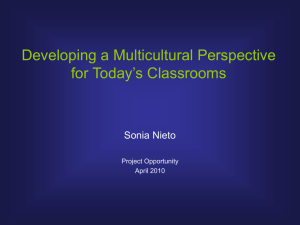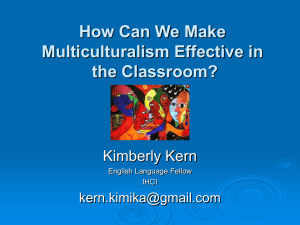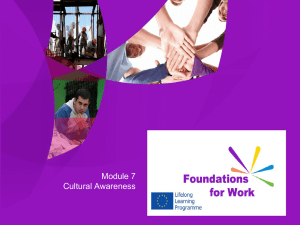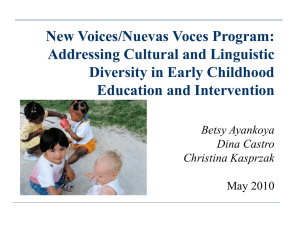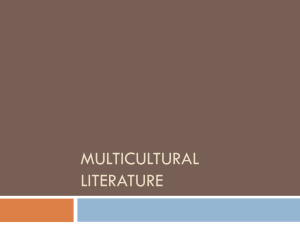Building Blocks: The First Steps of Creating a Multicultural Classroom
advertisement
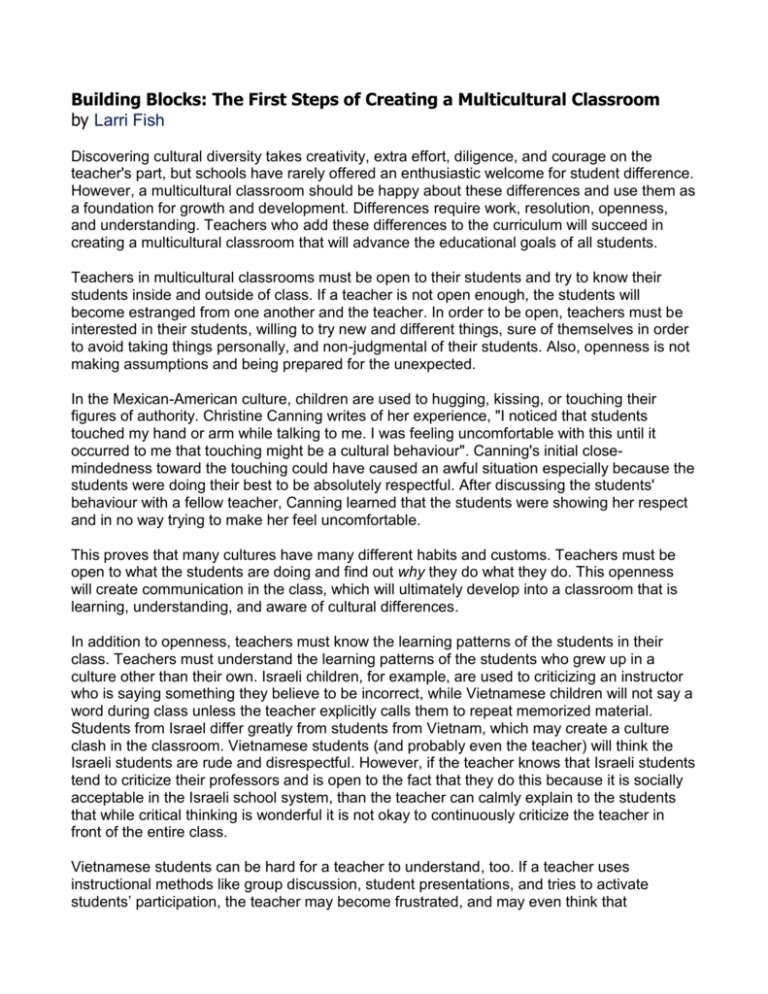
Building Blocks: The First Steps of Creating a Multicultural Classroom by Larri Fish Discovering cultural diversity takes creativity, extra effort, diligence, and courage on the teacher's part, but schools have rarely offered an enthusiastic welcome for student difference. However, a multicultural classroom should be happy about these differences and use them as a foundation for growth and development. Differences require work, resolution, openness, and understanding. Teachers who add these differences to the curriculum will succeed in creating a multicultural classroom that will advance the educational goals of all students. Teachers in multicultural classrooms must be open to their students and try to know their students inside and outside of class. If a teacher is not open enough, the students will become estranged from one another and the teacher. In order to be open, teachers must be interested in their students, willing to try new and different things, sure of themselves in order to avoid taking things personally, and non-judgmental of their students. Also, openness is not making assumptions and being prepared for the unexpected. In the Mexican-American culture, children are used to hugging, kissing, or touching their figures of authority. Christine Canning writes of her experience, "I noticed that students touched my hand or arm while talking to me. I was feeling uncomfortable with this until it occurred to me that touching might be a cultural behaviour". Canning's initial closemindedness toward the touching could have caused an awful situation especially because the students were doing their best to be absolutely respectful. After discussing the students' behaviour with a fellow teacher, Canning learned that the students were showing her respect and in no way trying to make her feel uncomfortable. This proves that many cultures have many different habits and customs. Teachers must be open to what the students are doing and find out why they do what they do. This openness will create communication in the class, which will ultimately develop into a classroom that is learning, understanding, and aware of cultural differences. In addition to openness, teachers must know the learning patterns of the students in their class. Teachers must understand the learning patterns of the students who grew up in a culture other than their own. Israeli children, for example, are used to criticizing an instructor who is saying something they believe to be incorrect, while Vietnamese children will not say a word during class unless the teacher explicitly calls them to repeat memorized material. Students from Israel differ greatly from students from Vietnam, which may create a culture clash in the classroom. Vietnamese students (and probably even the teacher) will think the Israeli students are rude and disrespectful. However, if the teacher knows that Israeli students tend to criticize their professors and is open to the fact that they do this because it is socially acceptable in the Israeli school system, than the teacher can calmly explain to the students that while critical thinking is wonderful it is not okay to continuously criticize the teacher in front of the entire class. Vietnamese students can be hard for a teacher to understand, too. If a teacher uses instructional methods like group discussion, student presentations, and tries to activate students’ participation, the teacher may become frustrated, and may even think that Vietnamese students are below average students. This is not the case, however; Vietnamese students are simply used to sitting, listening, and reciting memorized information. Students in Vietnam do not participate in the class and believe everything that the instructor says is absolutely true. So, teachers who open themselves up to cultural difference will effectively manage culture clash, while teachers who assume that Israeli students are rude and Vietnamese students are dumb will close communication in the classroom and destroy any hope of having a multicultural classroom. The best way to handle culture clash is to be open and not be afraid to talk about cultural differences. An open teacher will create an open class and an open class will have open lines of communication that will create a positive and beneficial learning environment for everyone. Language difference is another major issue in a multicultural classroom. A teacher who tries to learn the native language of her or his students (even only a word or two) will convey respect for the culture of the students and increase their self-esteem and feeling of acceptance. Introducing the language or culture of all students in the class into the curriculum will communicate that students of that culture are important. Perhaps the biggest fault of a textbook that contains information from a Western perspective is that it will suggest that the European-American culture is the most important culture and that Caucasians are somehow superior to other cultures. Certainly this is not true, but in the immediate past and even today our educational system is sending this message to students across the Western world. However, multicultural classrooms should incorporate content from different cultures EVERYDAY so that all cultures are considered valuable and wonderful. Howard Miller suggests that one very simple way for ALL teachers to add multicultural ideas and content to his or her curriculum is to build a classroom library of multicultural literature in all subjects. A math book written by an African author will send good messages to a population of students that has seen math books written by a European or an American. Teachers who own literature by authors from different backgrounds is great, but it is not enough. True multicultural activities must be ongoing and integrated daily in both informal and formal activities. Gloria Boutte and Christine McCormick suggest six basic principles for teachers to use when evaluating their culturally diverse classroom: 1) building multicultural programmes, 2) showing appreciation of differences, 3) avoiding stereotypes, 4) acknowledging differences in children, 5) discovering the cultural diversity within the classroom, 6) avoiding pseudo-multiculturalism. Showing appreciation of differences is very important because a teacher who does not show appreciation of all the differences in their class will not get the chance to attempt any of the other five principles. Teachers need to pay attention to their verbal and nonverbal language when he or she responds to students who speak, read or write differently. However, the most important thing to remember about all classrooms is that every child is unique. All children are different and beautiful in their own way; no students should feel excluded from the class, especially if the reason they feel they are excluded is based on culture, religion, ethnicity, or colour. An important step in teaching children to be comfortable with their cultural background and essentially themselves is to encourage and value them in a small group of other students. This has to do with the organization of the classroom and the development of lesson plans. When grouping students, teachers should put students from differing backgrounds and learning styles together. Students who are from a culture that prioritizes group achievement, cooperation, obedience, and respect toward authority tend to be externally motivated and more responsive to social activities, like group work. Countries that teach using a social structure and curriculum include Israel, Germany, and Italy, while students who are from cultures that emphasize individualism, personal initiative, and material well-being (Vietnam, Japan, United States) tend to be analytical, competitive, impersonal, and task-oriented. Although it is essential that students be considered as individuals, students will tend to be more like one category than the other. Grouping socially-oriented children with children who are task-oriented and impersonal allows the teacher to confront, explore, and celebrate difference. A teacher should be able to create projects for a group of students from different backgrounds that will require students to work together, allowing each student to be an important part of the group and learn information through the interaction of the group. Lesson plans that can do this and interest students will become invaluable for teachers and for the whole class. Hackett Middle School, located in Albany (New York, USA) is one of the most diverse schools in the United States. The student population is mixed between students of Latino, AfricanAmerican, European-American, Asian, and Mexican-American origins. I made a lot of striking observations while observing students during the year 2002. The first striking observation was the percentage of White students and students of other ethnicities in the “good” and "slow" classes. In the "good" group, there are thirteen White children and only eight students that are of a different ethnicity. The "slow" class, on the other hand, is comprised of two White students and nineteen students of different ethnicities (mostly Latino and African-American). Clearly, there are some inequities in the evaluation process that favour the Caucasian students. I also noticed something equally surprising on the 2 days I spent tutoring students in school suspension. All the students (16 total) in school suspension were of either African-American or Mexican-American descent. In a school that has such a large population of White students, why are none of them in suspension? That is an alarming fact. However, teachers at Hackett Middle School are doing a great job using multicultural literature and the other principles I have listed in this article. The "good" class has recently read The House on Mango Street by Sandra Cisneros, which is a story about a Hispanic girl named Esperanza and her search for identity while growing up in a town of mixed ethnicities. This is a huge step in creating a multicultural classroom that all teachers can do. Additionally, teachers are often putting students into multicultural groups these days. Creating multicultural classrooms is a priority for all teachers. This includes restructuring their techniques of evaluation and teaching, but, more importantly, it includes embracing difference and opening up the classroom for communication. Schools like Hackett Middle School are making vast improvements in this area, but there is so much more that we need to do. This is a colorful world; let us, the future teachers, make sure that we paint our classrooms with these colours every single day. Works Cited Boutte, Gloria S. and Christine McCormick. "Authentic Multicultural Activities: Avoiding Pseudomulticulturalism." Childhood Education 68 (1992): 140-44. Canning, Christine. "Getting from the Outside In: Teaching Mexican Americans When You Are an 'Anglo.'" High School Journal 78 (1995): 195-205. Jones, Charlotte M. Practical Applications of Multicultural Communication Theory in the Classroom Setting. Typed version of speech given at the Annual Meeting of The Western Speech Communication Association (Fresno, CA, Feb. 16-19, 1985). Kazemek, Francis E. "African Literature in the Secondary English Language Arts Classroom." English Journal 84 (1995): 95-102. Miller, Howard M. "Beyond 'Multicultural Moments' (Middle Gorund)." English Journal 86 (1997): 88-90. Perez, Samuel A. "Responding Differently to Diversity." Childhood Education 70 (1994): 15153. Tomic, Alice D. F. "Challenges and Rewards in the Mixed Culture Classroom." College Teaching 44 (1996): 69-73.
